 "Miroestrol and Deoxymiroestrol " is very different from other phytoestrogens found in other plants such as Barley. It posses highest estrogenic activity among the known phytoestrogens due to structural similarity to Estradial. Estradiol is the main human estrogen which can be found in all women who are at the stage of nursing baby (Lactating); as you may notice that all women who are in this stage, their breast will enlarge and gain firmness for feeding purpose. This is the main reason why Pueraria Mirifica is unique from other breast enhancement herbs such as Barley.
"Miroestrol and Deoxymiroestrol " is very different from other phytoestrogens found in other plants such as Barley. It posses highest estrogenic activity among the known phytoestrogens due to structural similarity to Estradial. Estradiol is the main human estrogen which can be found in all women who are at the stage of nursing baby (Lactating); as you may notice that all women who are in this stage, their breast will enlarge and gain firmness for feeding purpose. This is the main reason why Pueraria Mirifica is unique from other breast enhancement herbs such as Barley. Among some of the top rated epilators on the market today are Philips Epilators. They have some wonderful epilators using the best technology for smooth skin and even with pain softeners.
As examples of two of the most popular epilators we will look at Philips Epilator HP6443 Satinelle and Philips Satinelle Epilator HP6409.
The Philips Satinelle HP6443 is a two speed epilator with pain softener which improves the epilation. It is designed for all body areas, including the bikini line and underarms. The unique Pincette system uses 21 rotating discs that will remove even the shortest hair of 0.5mm. You will be able to choose from 2 speeds for fast and comfortable hair removal. The pain softener attachment is very easy to remove for cleaning. It comes in a mellow pink finish and includes a very nice storage or traveling pouch, cleaning brush and protective cap.
I went shopping with my friends and find a interesting thing .We find a lot of wholesale sterling silver jewelry, pearl pendant, cultured pearl earings, freshwater pearl ring, cheap pearl bracelet, cultured pearl necklace, pearl strands, pearl bracelets, wholesale pearl beads … in pearl wholesale store. All that pearl jewelries are designed with the best and the top d they offer all these types of pearl jewelry at deep discounted wholesale prices. I advise you to have a look. Do not go wrong.
Orignal From: Miroestrol and Deoxymiroestrol
 Speaking about general tendencies in a Russian woman's attitude to nutrition and cooking we should bear in mind that women in Russia differ from one another, as women everywhere in the world, in their habits, ways and affections. Some are fond of cooking and are culinary geniuses, others feel like criminals serving a life sentence of cooking. Still others would be happy to devote some time to cooking but can't allot any. One person is a culinary connoisseur, the other - is utterly unsusceptible to what she eats. One person adhere to some specific diet, the other will eat anything in any combinations.
Speaking about general tendencies in a Russian woman's attitude to nutrition and cooking we should bear in mind that women in Russia differ from one another, as women everywhere in the world, in their habits, ways and affections. Some are fond of cooking and are culinary geniuses, others feel like criminals serving a life sentence of cooking. Still others would be happy to devote some time to cooking but can't allot any. One person is a culinary connoisseur, the other - is utterly unsusceptible to what she eats. One person adhere to some specific diet, the other will eat anything in any combinations.  Meat. It is practically impossible to survive a severe Russian winter without meat, which is, first of all, a powerful source of energy. The idea of using concentrated dry broth cubes instead of fresh-made natural meat broth for cooking a soup will seem absurd to any Russian woman. The daily menu of most Russian families necessarily includes a meat or a sausage dish, though recently the number of women refriaining from eating meat products has increased. They are not vegetarians in full sense, more likely, they follow one of the theories that meat is bad for the body.
Meat. It is practically impossible to survive a severe Russian winter without meat, which is, first of all, a powerful source of energy. The idea of using concentrated dry broth cubes instead of fresh-made natural meat broth for cooking a soup will seem absurd to any Russian woman. The daily menu of most Russian families necessarily includes a meat or a sausage dish, though recently the number of women refriaining from eating meat products has increased. They are not vegetarians in full sense, more likely, they follow one of the theories that meat is bad for the body.  Dairy products. They take one of the top positions in the list of products Russians cannot do without. As a rule they use fresh dairy products, i.e. they are to be eaten within three days. Therefore these products do not contain any preservatives, so called "live" products. They are milk (fat content may vary from 1.5 to 3.5 per cent), fermented dairy products (kefir, ryazhenka, varenets, curdled milk, bifidok, etc.), cottage cheese products (cottage cheese, sweet cottage cheese paste, etc.), sour cream, yogurts. The consumption level of butter and cheese is also very high.
Dairy products. They take one of the top positions in the list of products Russians cannot do without. As a rule they use fresh dairy products, i.e. they are to be eaten within three days. Therefore these products do not contain any preservatives, so called "live" products. They are milk (fat content may vary from 1.5 to 3.5 per cent), fermented dairy products (kefir, ryazhenka, varenets, curdled milk, bifidok, etc.), cottage cheese products (cottage cheese, sweet cottage cheese paste, etc.), sour cream, yogurts. The consumption level of butter and cheese is also very high.  Very few RW buy pre-cooked meals. The concept is absolutely foreign to them. Do not be surprised if your wife mentions Russian food is much better the first time you go shopping in her new home. She is not being rude, she simply equates freshness to healthy food. Russian people prefer buying vegetables and fruits in markets because it is more fresh.
Very few RW buy pre-cooked meals. The concept is absolutely foreign to them. Do not be surprised if your wife mentions Russian food is much better the first time you go shopping in her new home. She is not being rude, she simply equates freshness to healthy food. Russian people prefer buying vegetables and fruits in markets because it is more fresh. 
 The materialism and extravagance of MTV's show is a far cry from what the average teen can expect. Thank goodness, or we'd have a nation of brats, which couldn't be farther from the truth. (TIME magazine's Anne Marie Cox wrote of MTV's teens in a recent article, "Their blingy flings are not celebrations of accomplishment; they're celebrations of self.") Even debutantes, those clichéd well-to-do southern belles, hold a coming out ball ostensibly not to show off, but to be formally introduced to polite society. What's more, these debutante balls are often charity occasions, "in which the parents of the young ladies, as well as all attending, must contribute a certain sum of money to the cause at hand," according to Wikipedia.
The materialism and extravagance of MTV's show is a far cry from what the average teen can expect. Thank goodness, or we'd have a nation of brats, which couldn't be farther from the truth. (TIME magazine's Anne Marie Cox wrote of MTV's teens in a recent article, "Their blingy flings are not celebrations of accomplishment; they're celebrations of self.") Even debutantes, those clichéd well-to-do southern belles, hold a coming out ball ostensibly not to show off, but to be formally introduced to polite society. What's more, these debutante balls are often charity occasions, "in which the parents of the young ladies, as well as all attending, must contribute a certain sum of money to the cause at hand," according to Wikipedia.  Sure, MTV's newest reality show, My Super Sweet Sixteen, which premiered last January, is designed to be over the top and outrageous. That's the whole point. It's the reality TV equivalent of a bloody train wreck: You are appalled, but you just can't avert your eyes. The kids are so obnoxious and so clueless as to how awful they sound, that you stay glued to your tube just to see what horrifyingly selfish thing they'll say or do next.
Sure, MTV's newest reality show, My Super Sweet Sixteen, which premiered last January, is designed to be over the top and outrageous. That's the whole point. It's the reality TV equivalent of a bloody train wreck: You are appalled, but you just can't avert your eyes. The kids are so obnoxious and so clueless as to how awful they sound, that you stay glued to your tube just to see what horrifyingly selfish thing they'll say or do next.  Pearls are also appropriate gifts for your mother, sister, or daughter. Let them know how pure your love is for them and how they have been a Pearl in your life! If you would like additional suggestions about gift giving, or helping make the women in your life happy, please email me anytime you like.
Pearls are also appropriate gifts for your mother, sister, or daughter. Let them know how pure your love is for them and how they have been a Pearl in your life! If you would like additional suggestions about gift giving, or helping make the women in your life happy, please email me anytime you like.  Cultured Pearls Made when a foreign substance is intentionally inserted into a living oyster.
Cultured Pearls Made when a foreign substance is intentionally inserted into a living oyster. 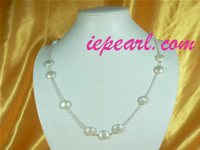 AA quality pearls have medium luster and slight to medium surface imperfection. They are ideal gifts for someone who will be happy to own a piece of fine pearl jewelry.
AA quality pearls have medium luster and slight to medium surface imperfection. They are ideal gifts for someone who will be happy to own a piece of fine pearl jewelry.  Pearls are among the most the most exquisite of the gemstones. Pearl jewelry is considered classically beautiful, and a demonstration of the wearer's fine taste. Pearls have been used for many purposes, including jewelry, for thousands of years and have become an entire industry, complete with a unique vocabulary.
Pearls are among the most the most exquisite of the gemstones. Pearl jewelry is considered classically beautiful, and a demonstration of the wearer's fine taste. Pearls have been used for many purposes, including jewelry, for thousands of years and have become an entire industry, complete with a unique vocabulary. 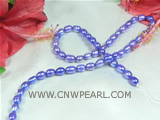 Freshwater pearls, which are often used for fashion pearl jewelry, grow in virtually every color of the rainbow. They are an affordable - though no less beautiful - alternative to traditional white, round saltwater Akoya pearls. Black Tahitian pearls, which are also saltwater cultured pearls, have overtones of peacock and silver and are most often have semi-round, baroque, and circle shapes.
Freshwater pearls, which are often used for fashion pearl jewelry, grow in virtually every color of the rainbow. They are an affordable - though no less beautiful - alternative to traditional white, round saltwater Akoya pearls. Black Tahitian pearls, which are also saltwater cultured pearls, have overtones of peacock and silver and are most often have semi-round, baroque, and circle shapes.  Traditionally, the standard for pearl jewelry has been to use white or near-white cultured pearls, freshwater pearls, or natural pearls that are perfectly round. The white, round beauties have been treasured because, in the world of pearl jewelry, they are rare. Increasingly, however, women are appreciating the uniqueness and versatility of pearls in a variety of shapes and colors - just as nature makes them. If you've always thought of pearls as white and round, it's time to think again.
Traditionally, the standard for pearl jewelry has been to use white or near-white cultured pearls, freshwater pearls, or natural pearls that are perfectly round. The white, round beauties have been treasured because, in the world of pearl jewelry, they are rare. Increasingly, however, women are appreciating the uniqueness and versatility of pearls in a variety of shapes and colors - just as nature makes them. If you've always thought of pearls as white and round, it's time to think again. 
 15th century. Unlike today, early birthstones were linked to the signs of the Zodiac instead of to calendar months. Almost everyone appreciates a birthstone, and it shows that you actually put some thought into the gift. Many people believe that wearing their birthstone protects them and brings them good luck. When giving a birthstone as a gift, think beyond rings to bracelets, pendants, earrings, pins and chokers.
15th century. Unlike today, early birthstones were linked to the signs of the Zodiac instead of to calendar months. Almost everyone appreciates a birthstone, and it shows that you actually put some thought into the gift. Many people believe that wearing their birthstone protects them and brings them good luck. When giving a birthstone as a gift, think beyond rings to bracelets, pendants, earrings, pins and chokers.  Pearls are the only gemstone created within another living organism. Natural pearls are grown without any human intervention when a speck of sand or other irritant lodges itself inside an oyster. Deteriorating environmental conditions have rendered natural pearls all but obsolete.
Pearls are the only gemstone created within another living organism. Natural pearls are grown without any human intervention when a speck of sand or other irritant lodges itself inside an oyster. Deteriorating environmental conditions have rendered natural pearls all but obsolete.  In times of rapid change, constants lend comfort to our lives. Since ancient times, jewelry has been one of the most popular gifts to give and to receive, and it still ranks among the top gifts as a universal, particularly pearls and birthstones. Jewelry ranks just beneath flowers as the gift that says "I love you," and it ranks just above flowers as a gift to convey that the recipient is someone special. A gift of jewelry delights the recipient and evokes a genuine smile.
In times of rapid change, constants lend comfort to our lives. Since ancient times, jewelry has been one of the most popular gifts to give and to receive, and it still ranks among the top gifts as a universal, particularly pearls and birthstones. Jewelry ranks just beneath flowers as the gift that says "I love you," and it ranks just above flowers as a gift to convey that the recipient is someone special. A gift of jewelry delights the recipient and evokes a genuine smile.  Hair styling products, deodorant, fragrance and any alcohol-based spray will break down the luster and finish on a pearl causing it to look pitty because the nacre layers will begin to peel off. The acid in our natural occurring body oils can build up on pearls which can make them look dull. It is best to wipe them off with a soft cloth or wash with a mild soap to remove a build up on the pearl surface. Do not dip in an ultrasonic cleanser, the damage would be immediate.
Hair styling products, deodorant, fragrance and any alcohol-based spray will break down the luster and finish on a pearl causing it to look pitty because the nacre layers will begin to peel off. The acid in our natural occurring body oils can build up on pearls which can make them look dull. It is best to wipe them off with a soft cloth or wash with a mild soap to remove a build up on the pearl surface. Do not dip in an ultrasonic cleanser, the damage would be immediate.  Natural pearls are rare and are usually found in estate sales or in museums from when European royalty discovered the Americas and the bays filled with oysters filled with naturally occurring pearls. Those pearls had an irritant that naturally made its way inside the muscle of the oysters started it producing layer upon layer of nacre which continued to build until the oyster was removed by men.
Natural pearls are rare and are usually found in estate sales or in museums from when European royalty discovered the Americas and the bays filled with oysters filled with naturally occurring pearls. Those pearls had an irritant that naturally made its way inside the muscle of the oysters started it producing layer upon layer of nacre which continued to build until the oyster was removed by men.  It is always important to get a independent laboratory report when in doubt of pearl enhancements that may have been employed to make the pearls appear more valuable. Make sure the person appraising the pearls is a Graduate Gemologist (GG) which is the Gemological Institute of America's (GIA)highest award.
It is always important to get a independent laboratory report when in doubt of pearl enhancements that may have been employed to make the pearls appear more valuable. Make sure the person appraising the pearls is a Graduate Gemologist (GG) which is the Gemological Institute of America's (GIA)highest award.  When choosing pearls also consider shape. There are three pearl shapes including symmetrical, spherical, and baroque. The spherical is the rarest and most desirable. Symmetrical pearls include teardrop or pear-shaped pearls and desirable but usually less expensive than spherical pearls. Baroque pearls are irregularly shaped and often the least expensive.
When choosing pearls also consider shape. There are three pearl shapes including symmetrical, spherical, and baroque. The spherical is the rarest and most desirable. Symmetrical pearls include teardrop or pear-shaped pearls and desirable but usually less expensive than spherical pearls. Baroque pearls are irregularly shaped and often the least expensive.  Luster is also important and one of the first factors to notice. Luster is an intense brightness that illuminates from within the pearl rather than just being "shiny" like in imitation pearls. The intense brightness results from light being reflected throughout the numerous layers of nacre. Quality pearls will have a sharp contrast between the brightest area where direct light is hitting the pearls and the shaded area creating an illusion of a "ball within the pearl." Check for luster by examining them under a fluorescent lamp and rolling them from side to side to examine uniform luster. Examine pearls over a light gray or white material and never black because it is harder to see the true quality of the pearl.
Luster is also important and one of the first factors to notice. Luster is an intense brightness that illuminates from within the pearl rather than just being "shiny" like in imitation pearls. The intense brightness results from light being reflected throughout the numerous layers of nacre. Quality pearls will have a sharp contrast between the brightest area where direct light is hitting the pearls and the shaded area creating an illusion of a "ball within the pearl." Check for luster by examining them under a fluorescent lamp and rolling them from side to side to examine uniform luster. Examine pearls over a light gray or white material and never black because it is harder to see the true quality of the pearl. 
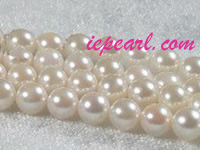 The major manufacturers of these cultured pearls are Japan and China. Kokichi Mikimoto developed a technique of producing the gem "on demand". But while he painstakingly created his methods, Tatsuhei Mise and government biologist Tokichi Nishikawa independently created the similar process of pearl culturing.
The major manufacturers of these cultured pearls are Japan and China. Kokichi Mikimoto developed a technique of producing the gem "on demand". But while he painstakingly created his methods, Tatsuhei Mise and government biologist Tokichi Nishikawa independently created the similar process of pearl culturing. 
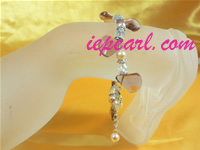 Although we know that the most genuine pearls are the natural pearls, yet we also know that they are very difficult to find. As a result they are also exorbitantly priced. It was thus not possible to meet the expanding demands for pearls in the market. Hence pearls began to be cultured and new and innovative ways were developed to produce harvests of a variety of pearls of different shapes sizes and colors. Different species of oysters and mussels were tested to get pearls of different colors and shapes and good luster. Over a period of time, we find that almost the entire market of pearls is flooded with cultured pearls. A great irony in the history of pearls is that the least expensive cultured pearl product in the market today rivals the quality of the most expensive natural pearls ever found. The price-value anomaly is obvious to consumers as they hasten to buy Chinese freshwater bargains.
Although we know that the most genuine pearls are the natural pearls, yet we also know that they are very difficult to find. As a result they are also exorbitantly priced. It was thus not possible to meet the expanding demands for pearls in the market. Hence pearls began to be cultured and new and innovative ways were developed to produce harvests of a variety of pearls of different shapes sizes and colors. Different species of oysters and mussels were tested to get pearls of different colors and shapes and good luster. Over a period of time, we find that almost the entire market of pearls is flooded with cultured pearls. A great irony in the history of pearls is that the least expensive cultured pearl product in the market today rivals the quality of the most expensive natural pearls ever found. The price-value anomaly is obvious to consumers as they hasten to buy Chinese freshwater bargains.  As you can well imagine, it's a long, tedious practice to find oysters that have ingested a piece of sand to produce a pearl. The longer a pearl stays inside an oyster, the larger it becomes. Because of this, quality pearls are considered rare and cost a pretty penny. Fortunately for those who favor this gem, there are now farms in which the irritant is deliberately injected into the mollusk to produce the pearl. These pearls are known as cultured.
As you can well imagine, it's a long, tedious practice to find oysters that have ingested a piece of sand to produce a pearl. The longer a pearl stays inside an oyster, the larger it becomes. Because of this, quality pearls are considered rare and cost a pretty penny. Fortunately for those who favor this gem, there are now farms in which the irritant is deliberately injected into the mollusk to produce the pearl. These pearls are known as cultured. 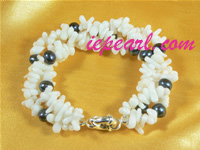 Try holding the pearls in your hand for a minute. Real pearls will feel cold initially, then will warm.
Try holding the pearls in your hand for a minute. Real pearls will feel cold initially, then will warm.  When combined, those two nucleation innovations are astounding developments. Once again the Chinese have radically altered freshwater culturing, making saltwater and freshwater techniques indistinguishable. They have also introduced a new type of culturing, nucleating with small tissue-nucleated pearls. Some of China's new pearls are all-nacre, some have nacre-coated nuclei, and all are unmarked. After one experimenter used small off-round naturals as nuclei, he sent the resulting freshwater pearls to a gem lab and received a report identifying them as "naturals." If pearl farmers can grow cultured pearls that test as naturals, the market may be in for a wild ride.
When combined, those two nucleation innovations are astounding developments. Once again the Chinese have radically altered freshwater culturing, making saltwater and freshwater techniques indistinguishable. They have also introduced a new type of culturing, nucleating with small tissue-nucleated pearls. Some of China's new pearls are all-nacre, some have nacre-coated nuclei, and all are unmarked. After one experimenter used small off-round naturals as nuclei, he sent the resulting freshwater pearls to a gem lab and received a report identifying them as "naturals." If pearl farmers can grow cultured pearls that test as naturals, the market may be in for a wild ride.  Bleaching, dying, and polishing is usually done. Except for the old Arabic practice of sun-bleaching in the Persian Gulf, naturals were practically never processed. Chinese pearls that are nearly white or mottled are usually bleached to make them whiter and more uniform. With the same methods perfected by the Japanese, the Chinese use a mild bleach, bright fluorescent lights, and heat. They polish surfaces by tumbling pearls in pumice or similar substances. The idea, as always, is to facilitate matching pearls for strands. Many Chinese pearls used to be dyed in the 1980s to bright red, blue, lavender, yellow or even black. In response to contemporary preferences, they now offer a selection of subtle natural colors.
Bleaching, dying, and polishing is usually done. Except for the old Arabic practice of sun-bleaching in the Persian Gulf, naturals were practically never processed. Chinese pearls that are nearly white or mottled are usually bleached to make them whiter and more uniform. With the same methods perfected by the Japanese, the Chinese use a mild bleach, bright fluorescent lights, and heat. They polish surfaces by tumbling pearls in pumice or similar substances. The idea, as always, is to facilitate matching pearls for strands. Many Chinese pearls used to be dyed in the 1980s to bright red, blue, lavender, yellow or even black. In response to contemporary preferences, they now offer a selection of subtle natural colors.